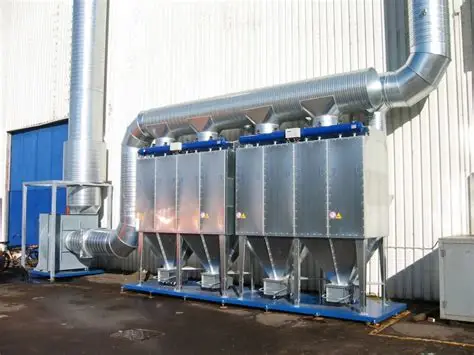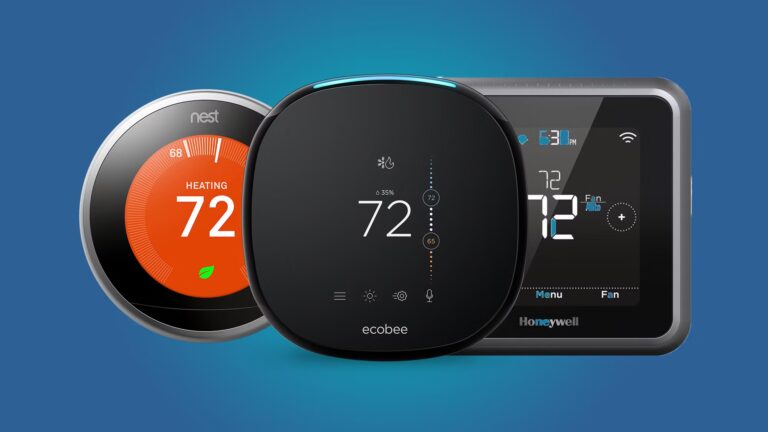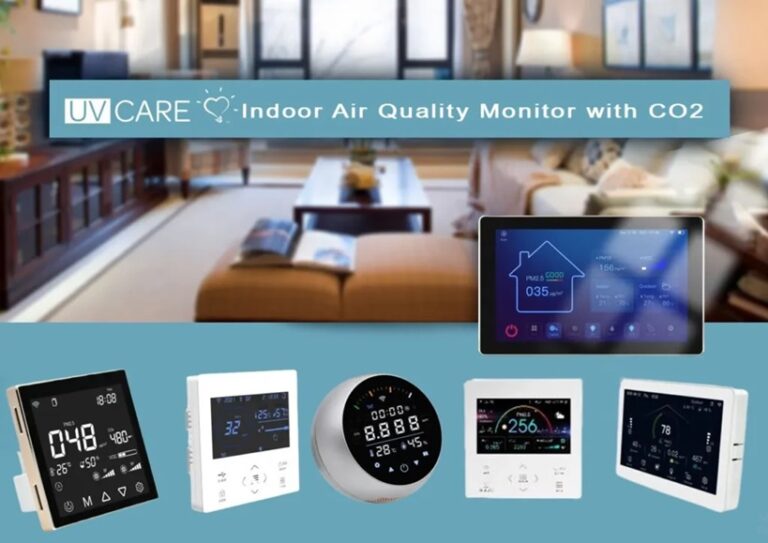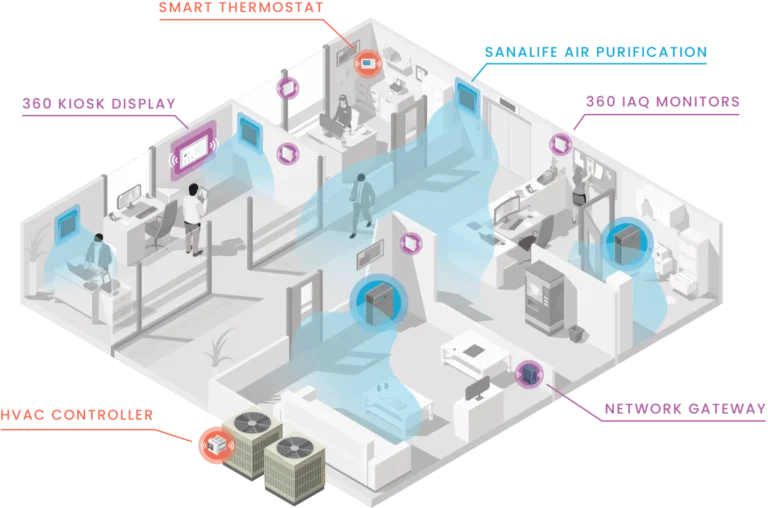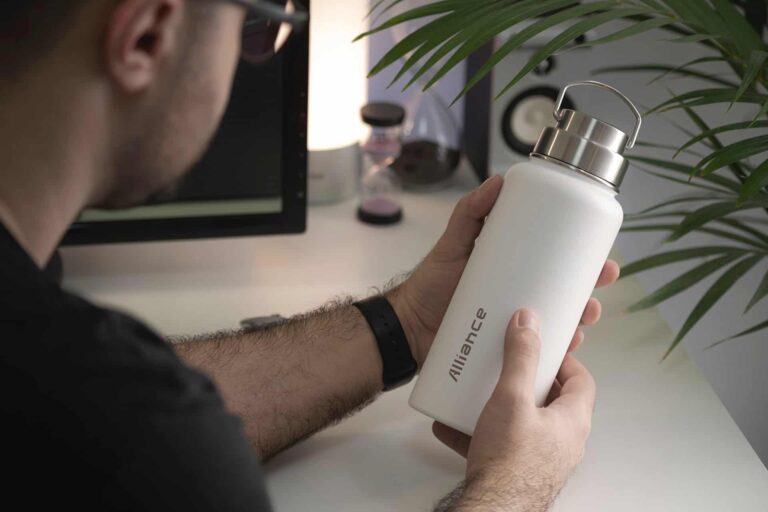🌬 Top 5 Commercial In-Duct Air Purification Systems (2026 Review + Scores)
Independent Evaluation • Updated for 2026 • Advanced HVAC IAQ Solutions
Major facilities are investing in in-duct air purification to go beyond basic filtration and actively improve indoor air quality. Buildings like offices, schools, healthcare centers, and light industrial plants face persistent challenges from airborne viruses, bacteria, allergens, and VOC chemical fumes that standard filters (even MERV 13/HEPA) may not fully address. Today’s solutions incorporate UV-C light, photocatalytic oxidation (PCO), bipolar ionization, plasma, and hybrid filter technologies to neutralize contaminants inside HVAC ducts before air reaches occupied spaces. Crucially, these modern systems are designed for zero ozone emissions (UL 2998 certified) and compliance with stringent standards like California’s CARB limit and ASHRAE 241-2023 for pathogen control.
📊 Clean Air Facts & Trends (Commercial Buildings)
✔️ Indoor air can be 2–5× (even 100×) more polluted than outdoors. The U.S. EPA reports indoor pollutant levels sometimes reach 100 times higher concentration than outside air. Occupants spend ~90% of their time indoors, so HVAC systems that only recirculate air can accumulate viral aerosols, mold spores, and VOCs.
✔️ Pathogens & VOCs bypass filters. Viruses and ultra-fine particles (<1 μm) often sneak through standard HVAC filters. Many odors and volatile organic compounds are too small or gaseous for even HEPA filters to capture. Advanced purification (UV-C, PCO, etc.) is needed to inactivate or break down these contaminants at the molecular level.
✔️ Safety certifications are non-negotiable. Reputable in-duct air purifiers now carry UL 2998 zero-ozone validation, meaning they emit <0.005 ppm ozone – far below the 0.050 ppm regulatory limit. ASHRAE 62.1 and California’s CARB require zero-ozone compliant devices in occupied buildings. All top systems reviewed here meet UL 2998 or equivalent testing for safe operation.
✔️ New standards demand “equivalent clean air.” ASHRAE Standard 241 (2023) introduces requirements for Equivalent Clean Airflow Rate to mitigate infectious aerosols in buildingspureaircontrols.com. Simply put, facilities must achieve a target air change rate with filtered or purified air. The following top systems can help meet or exceed these targets by providing proven pathogen removal rates and high clean air delivery.
✔️ Multi-technology approaches yield the best IAQ. The highest performing commercial purifiers use multi-stage purification – for example, germicidal UV + photocatalytic filters, or HEPA + electrostatic plasma – to address particulates, biologicals, and chemical pollutants together. Many also integrate with BAS/BMS controls or have IoT monitoring options to ensure performance and allow ventilation optimization for energy savings.
🧠 Scoring Categories (0–10 points each, 60 points total):
- Purification Effectiveness: Validated removal rates for pathogens (e.g. viruses, bacteria), particulates (PM2.5/PM1.0), and VOC/odor reduction. Larger real-world coverage and CADR-equivalent airflow are scored higher.
- Technology & Innovation: Uniqueness of purification method, safety of the tech (e.g. no harmful byproducts), multi-stage innovation, and integration into HVAC air streams.
- Installation & Integration: Ease of in-duct mounting or retrofit, compatibility with common AHUs/RTUs/fan-coils, available sizing options, and any smart controls or BMS integration features. Higher scores for flexible, plug-and-play units.
- Certifications & Safety: Compliance with UL 2998 (zero ozone), UL 867, CARB certification, ASHRAE 241 readiness, FDA 510(k) clearance (if applicable), and independent lab testing (Intertek, etc.). More certifications and third-party verifications = higher score.
- Maintenance & Lifecycle: Filter or bulb replacement intervals, self-cleaning features, maintenance difficulty/cost, and overall expected lifespan. Long-life consumables and minimal upkeep yield higher points.
- Value for Commercial Use: Price-to-performance ratio, warranty coverage, energy efficiency, and ROI (e.g. potential energy savings by reducing outdoor air needs, or improved occupant wellness). Consideration for multi-unit scalability and enterprise support.
Below is an overview of the Top 5 in-duct commercial air purification systems for 2026, ranked with transparent scoring. Each system includes a breakdown of scores, key specs, pros/cons, and ideal use cases. We also provide direct links to manufacturer specs or documentation for deeper reference.
🥇 Top 5 Ranking Summary (In-Duct Commercial Air Purifiers for 2026)
| Rank | System & Technology | Score (60) | Best For |
| 🥇 #1 | RGF HALO-LED™ (REME HALO Series) – UV/PCO + Bipolar Ionization | 56/60 | Best Active All-Around Purifier (balanced removal of microbes, VOCs & dust in most commercial HVAC systems) |
| 🥈 #2 | HealthWay Super V (DFS Filter) – Active HEPA-Grade Filtration | 55/60 | Best High-Capacity Filtration (medical-grade particle removal & germ killing – schools, offices, healthcare) |
| 🥉 #3 | Fresh-Aire UV APCO-X – UV-C Light + Activated Carbon PCO | 54/60 | Best Chemical-Free UV Treatment (odors, VOCs & germs – offices, retail, hospitals, etc.) |
| #4 | AtmosAir Matterhorn Series – Bipolar Ionization | 51/60 | Best for Large Venues & HVAC Energy Savings (stadiums, airports, big campuses with BAS integration) |
| #5 | Sanuvox Bio-Wall™ – High-Output UV Germicidal System | 49/60 | Best for Critical Disinfection (healthcare, labs & industrial HVAC needing maximum pathogen kill) |
🥇 #1: RGF HALO-LED™ (REME HALO Series) – Best Active All-Around Purifier

Score: 56/60 | Ideal For: Office buildings, schools/campuses, retail centers, senior living facilities, light industrial HVAC systems seeking comprehensive air sanitation.
⭐ Overview: RGF’s REME HALO series has become a benchmark for active in-duct air purification, and the HALO-LED model is its flagship 2026 offering. This system combines UV-C (LED) light and a patented catalyst to generate low-level hydroperoxide molecules and bipolar ions that continuously circulate with the HVAC airflow. Unlike passive filters, the HALO actively neutralizes bacteria, viruses, mold spores, and odors in situ and in the occupied space – RGF famously notes it can reduce a sneeze’s germs by 99% within 3 feet of the source. The LED-based UV element means no mercury and a much longer life (no lamp replacement for ~4–5 years). It installs into standard air ducts (plenum or supply) and creates an “air purification zone” throughout all rooms served by the HVAC system. After gaining popularity in thousands of schools and commercial buildings during the pandemic, the HALO-LED has amassed extensive real-world evidence of pathogen reduction. Importantly, the latest generation “REME HALO Zero” version is UL 2998 validated for zero ozone and CARB certified, addressing earlier concerns about ionizers. Overall, RGF’s HALO-LED offers a well-rounded, active purification solution that addresses particulates, microbes, and gases together, making it our top pick for broad IAQ improvement.
🔧 Key Specs:
- Technology: UV-C LED (advanced catalyst coating) + bipolar ionization module (active air & surface treatment).
- Coverage Capacity: Treats HVAC systems up to ~6 tons (2,400 CFM airflow) per unit. Multiple units can be used for larger air handlers.
- Safety & Compliance: UL 2998 zero ozone verified; Meets California CARB ozone limit; UL 867 certified. Hydroperoxide output is adjustable (shrouded cell) to meet ASHRAE and FDA safety levels.
- Installation: Duct-mounted via quick cut-hole (usually in supply plenum). 24 VAC hardwired (0.7 A). Comes with a transformer and mounting flange – typical install <1 hour.
- Maintenance: LED cell life ~45,000 hrs (~5 years continuous). The unit includes a Countdown timer on the power module to alert when replacement is due. No filter to replace; only the cell module (easy swap).
- Notable Features: Built-in ion generator (dual polar ion emitters) for particulate reduction; Active hydrogen peroxide at ~0.01 ppm for on-demand microbial disinfection; 5-year ballast warranty (2-year LED cell). HALO-LED is mercury-free and more energy efficient (17 W).
🧪 Scoring Breakdown (RGF HALO-LED):
- Purification Effectiveness: 10/10 – Excellent. Independently tested to kill up to 99% of viruses, bacteria, and mold in air and on surfaces (hydroperoxide + UV)atmosair.com. Also reduces VOC odors (food, pet, chemical) and helps drop particulate matter via ionization. Real-world use in schools and offices during COVID showed significant pathogen load reductions.
- Technology & Innovation: 9/10 – High. Pioneering combination of UV-PCO and bipolar ionization in one unit. The move to an LED UV source extends life and eliminates mercury. Patented aGHP® catalyst (activated gaseous hydrogen peroxide) is a novel “active air treatment” approach. Loses one point only because others now use similar multi-tech, but RGF remains an innovator (they hold multiple IAQ patents).
- Installation & Integration: 9/10 – Very Good. The device is compact and mounts simply through a duct cut-out with gasket and screws. It runs on 24 V, easily tied into HVAC controls or a plug-in transformer. No separate fan unit needed – it uses the HVAC blower. Integration with BAS is limited (no native BACnet), but the new HALO-LED module can be monitored via an optional RGF IoT hub.
- Certifications & Safety: 10/10 – Excellent. Verified zero ozone (UL 2998) and UL 867 listed. CARB certified for use in California. RGF provides extensive testing data (MS2 virus, Staph, etc.) showing safety and efficacyatmosair.com. Used in hospitals (RGF was even used in an FDA-approved air cleaning study, though HALO itself is not a medical device). No notable safety issues; hydroperoxide output is within natural levels found outdoorsjohnsoncomfort.com.
- Maintenance & Lifecycle: 10/10 – Excellent. Industry-leading low maintenance. The UV-LED cell lasts 4–5 years – far longer than typical 1-year UV lamps. No filter or plates to clean. The unit self-monitors cell life. Replacement cells are plug-and-play. The ballast and chassis are warrantied for 5 years, ensuring a long service life.
- Value for Commercial Use: 8/10 – Very Good. The HALO-LED isn’t the cheapest (~$$$ per unit installed), but it packs multi-function purification that might otherwise require two or three separate devices. For mid-sized buildings, it’s cost-effective and often eligible for HVAC improvement grants. Energy use is low (17 W). ROI comes from healthier indoor air (potentially fewer sick days) and moderate HVAC coil cleanliness benefits. Loses a couple points as large facilities with many air handlers must buy multiple units, but overall a solid value for broad IAQ improvement.
👍 Pros:
- Active Whole-Space Purification: Sends hydrogen peroxide plasma and ions throughout rooms, not just at the coil – continuously sanitizes air and surfaces. Great for reducing infectious aerosols in occupied spaces.
- Long-Life, Low-Profile Design: LED UV cell means 4+ years between replacements, no mercury, and minimal maintenance. Unit mounts flush in duct – no large footprint.
- Broad-Spectrum Efficacy: Tackles microbes, odors, and particles simultaneously. Tested 99%+ kill on bacteria and virus surrogatesatmosair.com; noticeable odor reductions (e.g. food, restroom smells); helps agglomerate fine dust for easier filtration.
- Zero Ozone & Certified Safe: UL 2998 validated (no ozone), CARB approved. Safe for continuous use in occupied areas – an important distinction from older ionizers or UV gadgets.
👎 Cons:
- Higher Initial Cost: One of the pricier in-duct options. The advanced cell and LED tech come at a premium, so outfitting a large building with many units can be costly (though prices have been dropping as production scales).
- Limited Particle Filtration: The HALO’s strength is in neutralizing biologicals and odors; it does not physically filter out all dust/PM. You’ll still need good HVAC filters – the ions help, but it’s not a HEPA.
- No Onboard Display or Connectivity: Aside from the countdown timer LED, the unit itself lacks a digital interface. Remote monitoring or control requires additional modules. Competing smart purifiers offer more BAS integration out-of-box.
🏁 Bottom Line: RGF’s HALO-LED is a field-proven, all-in-one air purifier for commercial HVAC systems that delivers continuous air cleaning beyond what any filter alone can do. It’s ideal for organizations that want an active IAQ solution – one that not only zaps microbes in the duct, but also releases a purifying plasma to corners of rooms. With virtually no ozone, a long-life LED, and easy retrofit install, the HALO-LED brings hospital-grade air sanitization to everyday workplaces. For most commercial buildings aiming to significantly reduce germs, odors, and allergens building-wide, the REME HALO is a top-tier choice in 2026.
🥈 #2: HealthWay Super V (Disinfecting Filtration System) – Best High-Capacity Filtration

Score: 55/60 | Ideal For: Hospitals, laboratories, office towers, schools, and any facility seeking medical-grade HEPA filtration plus germicidal protection integrated into HVAC.
⭐ Overview: The HealthWay Super V is a different breed of air purifier – essentially a whole-building electronic HEPA filter that actively kills what it catches. This in-line unit uses HealthWay’s patented DFS (Disinfecting Filtration System) technology: a high-efficiency pleated filter (MERV 16+/HEPA equivalent) combined with a high-voltage grid that creates a dielectric barrier to trap and destroy microorganisms on the filter. The result is 99.99% removal of bacteria and viruses, even tiny ones, from the airflow. Third-party labs confirmed a 4-log (99.99%) kill of MS2 RNA virus (a proxy for SARS-CoV-2) and Staph epidermidis (MRSA surrogate) in Super V units. In practical terms, the Super V provides hospital operating room-level air quality to an entire building’s ventilation system. It installs as a “point-of-entry” air cleaner in the duct, typically right after the air handler or at a main return. Despite its extreme filtration (captures particles down to 0.007 microns at 99% efficiency), the design is surprisingly HVAC-friendly – pressure drop is about half that of an equivalent HEPA, thanks to efficient laminar flow and the charged field that agglomerates particles. There are no UV lamps or ions emitted; all purification occurs within the sealed filter unit, which is UL certified and generates no ozone. For 2026, HealthWay has refined the Super V with larger models and smart monitoring (filter life indicators, etc.). It’s a top choice where maximum particulate removal and pathogen elimination are the priority (e.g. meeting stringent ASHRAE 241 air cleanliness targets).
🔧 Key Specs:
- Technology: DFS electrically enhanced filtration. Includes a pleated high-efficiency filter (greater than MERV 16, near-HEPA) in front of a high-voltage grid (~4 W) that charges and inactivates particles. Creates a microbial-inhibiting field across 211 sq. ft. of media.
- Performance: 99.99% kill of viruses & bacteria captured (tested on MS2 virus and S. epidermidis). Removes >99.6% of 0.3 µm particles and even ~99% of ultra-fine 0.007 µm particles – surpassing true HEPA. Clean Air Delivery Rate (CADR) is equivalent to that of a full HEPA system at similar airflow.
- Airflow & Sizing: Handles up to 2,000 CFM per unit (typical unit is ~27 × 24 × 14″ housing). Multiple units can be manifolded for large air handlers. Pressure drop at 2,000 CFM is ~0.27″ w.g. (which is about half of an equivalent standard filter).
- Integration: Installed in-line in duct (often in place of or in addition to existing filter rack). Requires 120 V outlet for the DFS power supply. Many come with BMS dry contacts or an optional IoT module for status. No moving parts; uses the main HVAC fan.
- Certifications: UL 2998 ozone-free compliant by nature (no ozone produced by DFS). The technology is an FDA listed Class II Medical Device in portable form (the same DFS tech in HealthWay portable units is FDA cleared). Also meets UL 867 safety. Used in NYC, LA, Chicago public schools per company data.
- Maintenance: Filter cartridges last up to 3 years in typical use (with intermittent fan operation – about 12–18 months if fan runs 24/7). A filter status light and pressure sensor indicate when to replace. Replacing the filter (about $200–$300) is the only maintenance; no bulbs or plates to clean. The whole unit has a 10-year warranty on materials.
🧪 Scoring Breakdown (HealthWay Super V):
- Purification Effectiveness: 10/10 – Outstanding. Achieves true HEPA-level particulate removal (captures virtually all pollen, dust, dander, even combustion smoke). Moreover, it inactivates 99.99% of captured microbes – essentially sterilizing the air. Few systems can claim a tested 4-log reduction of airborne viruses and bacteria. This high level of “clean air delivery” directly supports meeting ASHRAE 241 infection control targets.
- Technology & Innovation: 10/10 – Outstanding. HealthWay’s DFS is an award-winning innovation: it improves on standard HEPA by adding an electrostatic disinfecting field that not only boosts efficiency but also neutralizes pathogens. This tech was developed with military grants and is used in mission-critical cleanrooms. It’s essentially a self-cleaning HEPA – very novel in commercial HVAC.
- Installation & Integration: 8/10 – Good. Installation involves adding the metal filter housing into the duct line, which is more involved than a UV wand but similar to installing a large bypass filter. It requires sufficient space and may need duct transitions. However, once in place, it’s mostly set-and-forget. Integration with HVAC is seamless (just replace existing filter section). It lacks built-in network connectivity (score could be higher if it had native BACnet/Modbus – currently only via add-ons).
- Certifications & Safety: 9/10 – Excellent. While not a UV or ion device, it inherently produces no ozone or harmful byproducts. Units are tested to meet rigorous medical-grade standards. The company publishes data verified by LMS Technologies and ARE Labs showing pathogen kill. One point off only because it doesn’t specifically list UL 2998 (likely because it has no emissions anyway). In practice, it far exceeds safety requirements and is used in sensitive healthcare environments.
- Maintenance & Lifecycle: 9/10 – Excellent. Filters last 1–3 years depending on usage, which is far longer than standard filters, thanks to the large surface area and particle agglomeration effect. The high-energy grid prevents microbial growth on the filter, so no risk of moldy filter. Maintenance is infrequent and simple (swap cartridge). Deducting one point as filter replacements do cost more than, say, a UV lamp – but considering the interval and performance, it’s very reasonable.
- Value for Commercial Use: 9/10 – High. For the level of air purity delivered, the Super V provides strong value. It effectively combines the roles of a top-tier filter and a UV air sanitizer in one unit. Energy impact is moderate: pressure drop is low for the efficiency (saving fan energy), and the DFS grid draws only ~4 W. The initial cost is higher than simple UV gadgets, but coverage per unit is large (one unit can often handle a whole floor). Many businesses see ROI in improved occupant health (allergy and illness reduction) and in meeting green building IAQ credits. HealthWay’s long warranty also adds value.
👍 Pros:
- Unmatched Filtration Efficacy: Delivers cleanroom-grade air – >99.99% viral/bacterial removal, plus captures ultra-fines down to 0.007 µm. No other tech on this list matches its particulate removal; ideal for environments with smoke, smog, or high-allergen concerns.
- Kills Pathogens (Doesn’t Just Trap Them): The DFS electrostatic field actively kills microbes on the filter within minutes. There’s no risk of bacteria breeding on the filter or blowing back into the air, which can happen with ordinary filters.
- Long Life & Low Maintenance: Huge filter capacity means replacements are rare (12–36 months). The unit includes alerts for filter changes. No UV lamps or ion tubes to service. This is well-suited for facilities with limited maintenance staff.
- No Ozone or Chemical Byproducts: 100% passive to the occupied space – it simply outputs ultra-clean air. UL-certified for safety. Unlike some active purifiers, it adds no ozone, no plasma, no residuals into rooms, which is important for the most sensitive populations (hospitals, childcare).
👎 Cons:
- Installation Space & Effort: The Super V housing is sizable; retrofitting it may require duct modifications or space that small rooftop units don’t have. In tight HVAC systems, fitting a 2-ft long filter box can be a challenge. Install usually needs a professional sheet-metal tech.
- Higher Upfront Cost: This level of filtration doesn’t come cheap – the unit and filter are an investment, often justified for health-critical environments. Smaller businesses on a budget might find it pricey compared to simpler UV lights (though those don’t achieve the same results).
- Focus on Particulates/Microbes Only: The system does not actively remove VOCs or odors (no carbon media standard, though a pre-filter option with carbon exists). So while it excels at germs and dust, you might need an add-on solution for heavy chemical odors or gas-phase pollutants.
🏁 Bottom Line: If your goal is to provide hospital-grade, ultra-pure air through your HVAC, the HealthWay Super V is the gold standard. It turns your ductwork into a germ-killing, particle-scrubbing machine, all without emitting anything but clean air. Schools, offices, and medical facilities have deployed these systems to great effect – often to meet stringent IAQ standards or to reassure occupants (the technology’s FDA-classified pedigree helps there). While installation and cost require planning, the payoff is an HVAC system that not only filters, but disinfects the air continuously. For scenarios where maximum filtration is non-negotiable (pandemic preparedness, smoke events, severe allergies), the Super V is a wise investment and stands out as the best high-capacity filtration purifier in the commercial market.
🥉 #3: Fresh-Aire UV APCO-X – Best Chemical-Free UV Treatment (Odors & Germs)
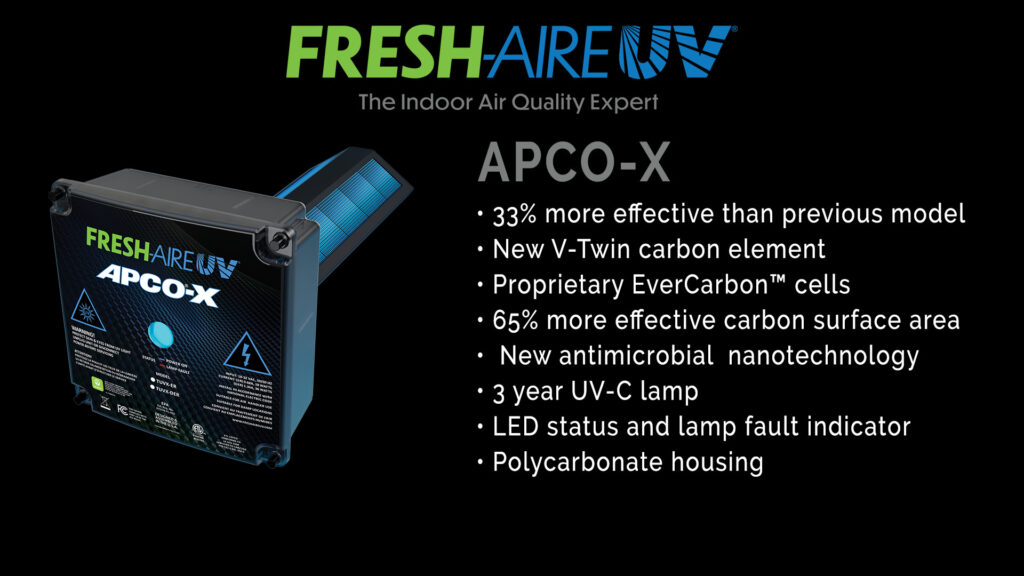
Score: 54/60 | Ideal For: Restaurants, retail and office buildings, hospitals/clinics – sites needing to eliminate odors, VOC fumes, and biological growth in HVAC systems with minimal maintenance.
⭐ Overview: The APCO-X by Fresh-Aire UV (Triatomic Environmental) is a leading dual-technology purifier that integrates UV-C sterilization with Photocatalytic Oxidation (PCO) to neutralize both biological and chemical pollutants. Unlike systems that generate ions or reactive gases, APCO-X is a “chemical-free” purifier – it uses UV light (254 nm germicidal) shining on a proprietary EverCarbon™ matrix infused with titanium dioxide catalyst. This combination continuously inactivates microorganisms (like mold, bacteria, viruses) and breaks down VOCs/odors into harmless compounds. APCO-X is typically installed at the evaporator coil or main supply plenum, where it not only disinfects the air stream but also bathes the coil in UV to prevent mold growth (a nice HVAC performance benefit). The “X” is the newest generation, boasting 65% more carbon surface area and 33% improved performance over the earlier APCO models. Importantly, independent testing shows APCO-X can safely address ~99% of contaminants in a home or building’s air within a few hours. It produces zero ozone (UL 2998 validated) and has a lifetime warranty on the system (with a UV lamp replacement every 3 years). In practice, APCO-X is loved for its ability to “clear the air” of smells (food, garbage, musty odors) while also killing germs – all with virtually no pressure drop and a very straightforward installation.
🔧 Key Specs:
- Technology: Dual-stage UV/PCO. A 13.5″ UV-C lamp (254 nm) irradiates an activated carbon honeycomb matrix. UV destroys microbes and energizes the matrix’s titanium dioxide coating to oxidize VOCs into CO₂ and H₂O. No ozone or chemicals are released (PCO process is internal).
- Installation: Duct-mounted unit with a remote UV lamp and an adsorptive matrix that extends into the air stream. Often mounted just above the AC coil in the supply plenum for dual benefit (coil irradiation + air treatment). Requires 24 VAC power (unit draws ~16 VA). The lamp shines 360° for maximum exposure.
- Coverage: One APCO-X unit treats up to ~5 tons or ~2,000 CFM of HVAC airflow (typical for ~2,000 sq ft area). For larger systems or heavy odor loads, multiple units can be used (Fresh-Aire offers rack systems for big AHUs).
- Build & Features: The EverCarbon™ matrix has an antimicrobial nanotech coating and is rated for life (no replacement). The UV lamp is a special long-life quartz bulb rated for 3 years continuous use. The housing is UV-resistant polymer with an LED status indicator for lamp operation/fault.
- Certifications: UL 2998 validated (zero ozone emissions). UL 1598 and CSA C22.2 electrical safety. Complies with ASHRAE guidelines for air disinfection (UV). Tested by third-party labs – e.g. Standard ISO 15714 UV dose evaluation (Fresh-Aire publishes microbial reduction data for MRSA, flu, mold, etc., generally >90% reductions in 4 hours). CARB certified for California.
- Maintenance: UV lamp replacement every 2–3 years (the APCO-X lamp is a 3-year rated bulb, a big improvement over standard 1-year UV lamps). No filters to replace – the carbon matrix is permanent (it doesn’t get “filled” with VOC; instead, it catalyzes them). One can vacuum the matrix if dust-covered, but generally it’s low-maintenance. Backed by a Lifetime warranty on all parts except the lamp.
🧪 Scoring Breakdown (Fresh-Aire APCO-X):
- Purification Effectiveness: 9/10 – Excellent. APCO-X is proven to significantly reduce biologicals and chemical odors. In testing, it achieved over 99% kill of mold spores, viruses, and bacteria on surfaces within a few hours, and it continually neutralizes common indoor VOCs (formaldehyde, toluene, etc.) that cause odors. It also keeps coils ultra-clean, preventing the biofilms that can breed bacteria. Loses 1 point because it doesn’t actively remove dust/particles (it targets microbes/VOCs primarily, relying on your HVAC filter for particulate).
- Technology & Innovation: 8/10 – Very Good. Fresh-Aire UV has refined PCO technology with the “V-Twin” carbon matrix and 3-year UV lamp. The innovation here is in material science – the EverCarbon matrix is more effective and never needs replacing, which is a big plus. However, PCO itself is a well-established tech in IAQ; APCO-X simply executes it extremely well rather than inventing an all-new method.
- Installation & Integration: 9/10 – Excellent. The unit is relatively compact and installs in any orientation (up-flow, down-flow, horizontal). Magnetic mounting brackets and a simple cut-out make it an easy add-on for most ducts. It doesn’t impede airflow (pressure drop <0.01″). While it doesn’t have built-in smart integration, it basically ties into the HVAC like a UV light – very straightforward. The provided LED indicator gives local status.
- Certifications & Safety: 10/10 – Excellent. No ozone production (UL 2998 certified), so it’s safe in occupied spaces. Fresh-Aire UV was among the first to earn UL 2998 for PCO devices. The UV wavelength is 254 nm (non-ozone producing). Numerous health systems and government facilities use APCO, indicating trust in its safety. The product is UL listed and has undergone extensive testing for efficacy (even validated against SARS-CoV-2 by third parties, with rapid virus inactivation on surfaces).
- Maintenance & Lifecycle: 9/10 – Excellent. Only one consumable: the UV lamp, replaced every 3 years. This is far less frequent than most UV systems (many require annual lamps). The catalyst doesn’t wear out. Maintenance is basically set a reminder for lamp change – that’s it. The unit hardware has a lifetime guarantee, reflecting its durable design. We deduct 1 point simply because you do have to remember to change the lamp eventually, but overall it’s nearly maintenance-free.
- Value for Commercial Use: 9/10 – High. Given that one APCO-X unit performs three functions (air disinfection, odor/VOC removal, and coil cleaning), it provides great value. The initial cost (moderate $$) is comparable to a quality UV light kit, but here you also get VOC mitigation that usually would require activated carbon filters (which are expensive and pressure-drop heavy). It saves energy by keeping coils clean (restoring heat exchanger efficiency). Also, no ongoing filter replacements – just a lamp every few years. The strong warranty and proven results make it a wise investment for building owners looking at long-term IAQ improvement.
👍 Pros:
- Dual Action (Microbes + Odors): One device addresses the “other two-thirds” of IAQ contaminants filters miss – it kills germs and breaks down odor-causing molecules. Ideal for resolving issues like persistent chemical smells, restroom odors, or kitchen exhaust infiltration in commercial buildings.
- Continuous Coil Disinfection: Placed at the coil, APCO-X prevents mold growth on HVAC fins and drip pans. This not only improves air quality (no “dirty-sock syndrome”) but also maintains HVAC efficiency (clean coils transfer heat better). It’s like an automatic coil cleaner.
- Zero Ozone, All Safe: Uses UV-C and photocatalysis – no ozone or off-gassing. UL 2998 and validated “no harmful byproducts”. This eases any liability concerns about adding air cleaners.
- Set-and-Forget Reliability: The carbon matrix never needs replacing, and the 3-year UV lamp reduces maintenance frequency by 3× compared to standard lamps. The system quietly does its job in the duct without operators needing to tweak anything.
👎 Cons:
- No Direct Particulate Removal: APCO-X won’t reduce dust or allergens except indirectly by keeping the system cleaner. You still rely on HVAC filters for particle capture. So it’s not a standalone solution if particle pollution (e.g. wildfire smoke) is a primary concern – it excels more at microbes and gases.
- Effectiveness Relies on Airflow: As an in-duct UV/PCO device, it treats air as it circulates. It may take several air exchanges to significantly reduce a high concentration of VOCs in a space. In a situation with a sudden odor spike or very large space, it’s not instantaneous (though coil proximity helps as many VOCs off-gas at the coil).
- Lamp Replacement Required: While infrequent, it’s still a recurring task/cost every 2.5–3 years. Forgetting to replace the UV lamp will render the unit ineffective (the carbon matrix alone won’t do much without UV activation). Fortunately, the unit’s indicator makes this easy to track.
🏁 Bottom Line: The Fresh-Aire APCO-X stands out as a versatile, low-maintenance air purifier that’s especially adept at scrubbing away unpleasant odors and chemical pollutants while also disinfecting the air. For commercial settings like restaurants, offices, or healthcare facilities where smells and germs are both concerns, APCO-X offers a proven one-two punch: UV germicidal power plus photocatalytic VOC neutralization. It requires virtually no attention after installation, and it won’t generate any ozone or residuals. In summary, if you want a cleaner coil, fresher-smelling indoor air, and reduced microbial counts – all with a simple in-duct unit – the APCO-X is a top contender that delivers a big IAQ upgrade for a relatively modest effort.
#4: AtmosAir Matterhorn Series – Best for Large Venues & HVAC Energy Savings
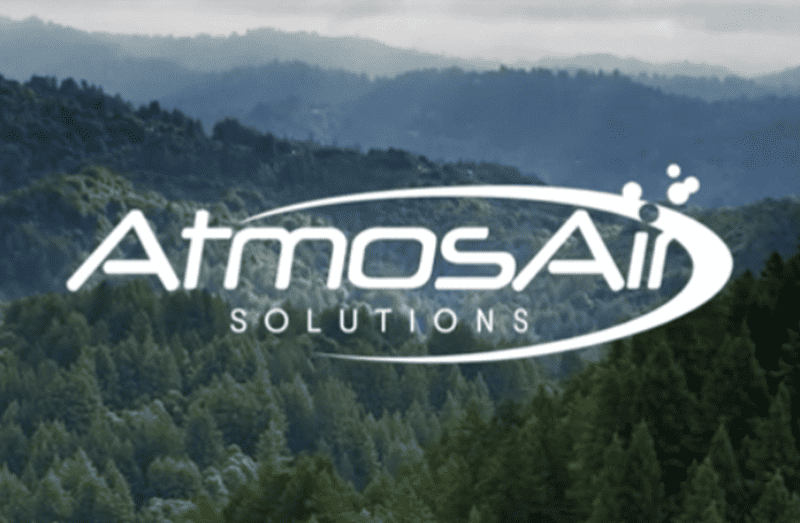
Score: 51/60 | Ideal For: Airports, arenas, convention centers, casinos, office complexes – big buildings needing scalable bipolar ionization for broad airborne pathogen and particulate control, potentially to reduce outside air requirements.
⭐ Overview: AtmosAir’s Matterhorn Series is a commercial bipolar ionization system that has gained fame in large-scale applications (stadiums, skyscrapers, even cruise ships). It uses specialized ion tubes mounted in ducts or air handlers to flood the airstream with positive and negative oxygen ions – much like refreshing outdoor mountain air (hence the “Matterhorn” name). These ions travel into occupied spaces, actively seeking out and neutralizing airborne pollutants: they cause particles to cluster and drop out of the air, and they oxidize VOCs and destroy microbes’ ability to infect. A key strength of AtmosAir is extensive third-party validation: in a lab test, AtmosAir BPI cut airborne coronavirus (229E) by 99.92% in 30 minutesatmosair.com, and other studies showed ~99.9% reduction of flu virus and bacteria. It’s also proven to reduce particle levels (Intertek testing showed ~85.8% reduction of sub-micron particles in a controlled environment). The system consists of rack-mounted ionization tubes (glass composite tubes with emitters) and a power controller. The emitters do not produce ozone (UL 2998 certified) – a huge improvement over earlier ion tech – so it’s safe for continuous use. For 2026, AtmosAir offers advanced IoT integration: their AtmosSmart™ platform can monitor ion levels and air quality in real-time, adjusting output as needed. One of the biggest appeals of AtmosAir is the potential energy savings: by cleaning recirculated air, facilities can sometimes reduce the amount of outside air they need to meet ventilation standards, thus saving HVAC energy (with engineering analysis per ASHRAE 62.1). Overall, AtmosAir’s combination of broad coverage, low maintenance, and proven pathogen reduction makes it a go-to solution for large commercial and institutional projects.
🔧 Key Specs:
- Technology: Needlepoint Bipolar Ionization (NPBI). Pairs of energized electrodes create a plasma field that generates a high concentration of positive and negative oxygen ions (output in the millions of ions/cc). These ions disperse with airflow to treat the space. No UV, no chemicals – just charged oxygen clusters.
- Product Line: The Matterhorn Series includes models like the SGFC and Tube Series that mount in air handlers or ducts of various sizes. For example, the AtmosAir 1002 model can handle up to ~4,800 CFM per tube. Systems can be scaled with multiple tubes for large AHUs (they offer rack assemblies to hold many tubes in big air plenums).
- Power & Controls: Typically 120–240 V powered, drawing modest wattage (approx. 10–30 W per tube). Many models have an adjustable output dial and can interface with a Building Management System (via dry contact or 0-10V control for ion output). AtmosAir also provides an AtmosAware air quality sensor that can be deployed in spaces to feed IAQ data to the controller (optional).
- Installation: Tubes are installed either in the supply duct or in the air handler near the fan outlet. They are mounted via brackets, and the tube electrodes protrude into the air stream. Installation is relatively easy – power to a nearby junction box and mount the tube. No major pressure drop introduced.
- Coverage & Performance: An array of ionization tubes can cover very large air volumes (the tech has been used in 50,000+ sq ft casinos, arenas, etc.). In-room ion density of 1,500–2,000 ions/cc is targeted for optimal effect. Verified results: 99.9% viral reduction in laboratory chamber testsatmosair.com; substantial reductions in TVOCs and odors in field deployments (e.g. smoke elimination in hospitality venues).
- Safety & Certifications: UL 2998 validated (zero ozone emission). UL 867 listed. Compliance with ISO 16000-37 test methodology for air ionizers. AtmosAir’s tech was among the first ion systems tested to not produce ozone while still effectively neutralizing contaminants. Also GREENGUARD Gold certified for indoor use.
- Maintenance: Ion tubes last ~2 years before needing replacement. They do not typically require cleaning in the interim (no dust buildup on emitters thanks to carbon fiber brush design in newer tubes). Maintenance is simply to swap out tubes (a quick process) on schedule. The system self-monitors via an LED or alarm for any faults. No filters or other consumables.
🧪 Scoring Breakdown (AtmosAir Matterhorn):
- Purification Effectiveness: 8/10 – Very Good. AtmosAir has solid data showing it reduces a broad spectrum of contaminants: from viruses (99.9%+ in lab tests)atmosair.com, to bacteria and mold (often 90–99% range), to particulate matter (~85% less PM2.5 in tests), and even odors (smoke, VOC) to an extent. In real-world large spaces, it has noticeably improved air quality (e.g. installed in the Staples Center and Cleveland Clinic with reported success). It’s not a HEPA filter, but by augmenting your existing ventilation, it significantly boosts overall air cleanliness.
- Technology & Innovation: 8/10 – Very Good. Bipolar ionization itself is not new, but AtmosAir has innovated in tube design and smart controls. Their systems avoid unwanted byproducts (no ozone, minimal NOx) and they offer a data-driven approach with sensors and IoT, which is cutting-edge for air purification. Still, it’s fundamentally an ion emitter – which some competing brands also do – so we give credit for improvements, though not an entirely unique tech.
- Installation & Integration: 8/10 – Good. For large HVAC systems, installing multiple ion tubes is generally easier than retrofitting bulky filters or banks of UV lights. It’s modular and scalable. Integration with BAS is available (you can control ion output or get alarm status). One challenge: ensuring even ion distribution in complex duct layouts – proper commissioning is needed. But overall, very workable and often simpler than adding massive filter racks.
- Certifications & Safety: 10/10 – Excellent. AtmosAir has addressed safety head-on: it’s UL 2998 ozone-free and tested by independent labs for safety and efficacy. ASHRAE and public health experts raised concerns about ionizers in the past; AtmosAir’s data and certifications have helped alleviate these (their tech was even used in the White House and validated by the DoD). They actively publish testing resultsatmosair.com. Full marks here – it meets all relevant standards and then some.
- Maintenance & Lifecycle: 8/10 – Good. Needing to replace tubes every 2 years is a moderate maintenance demand – it’s not difficult, but it is recurring. On the plus side, there are no filters to clog or clean, and no lamps to wipe. Some competing ion systems claim longer life or self-cleaning electrodes; AtmosAir’s 2-year interval is pretty standard. The control units themselves last many years.
- Value for Commercial Use: 9/10 – High. For large facilities, AtmosAir can be very cost-effective. One system can treat a huge volume of air without significant fan energy penalty (no pressure drop). Many clients have used it to reduce outside air intake (with engineering approval), leading to HVAC energy savings of 20–30% in some cases. That energy ROI plus relatively low capital cost per CFM treated is a strong value proposition. Also, the ability to cover an entire arena or high-rise with relatively few components gives it an edge in value for scale.
👍 Pros:
- Whole-Building Coverage: Ions circulate throughout all rooms served by the system, purifying air in occupied spaces (not just in the duct). Great for very large or open layouts where you want uniform treatment.
- Scalable & Low Profile: Easy to scale up – just add more ion tubes for bigger airflow. No big units taking up floor space; everything is tucked in the HVAC system. For retrofits in older buildings, this is far easier than adding bulky equipment.
- Proven in High-Occupancy Environments: Used successfully in sports arenas, airports, and hospitals, reducing airborne virus transmission risksatmosair.com. It’s one of the few technologies that directly addresses infectious aerosols in the space, which is a big deal post-2020.
- Potential Energy Savings: By cleaning recirculated air, facilities may be allowed to lower the required fresh air ACH (per ASHRAE 62.1 Indoor Air Quality Procedure), which translates to lower heating/cooling costs. AtmosAir often markets this as a way to improve IAQ and save on utilities – a unique advantage among purifiers.
👎 Cons:
- Effectiveness Can Vary with Conditions: Ionization performance depends on factors like humidity, airflow patterns, and existing particle levels. In very dry climates or if not tuned well, results may be less dramatic. It’s also less immediately tangible – you don’t “see” ions working (though you might smell cleaner air). Proper engineering design is needed to ensure ion density targets are met.
- Replacement of Ion Tubes: Every 2 years the tubes must be swapped – for a large campus with dozens of units, that’s a maintenance task to schedule (though not overly burdensome). Skipping replacements leads to diminished performance.
- Public Perception & Byproducts: While AtmosAir is ozone-free, some critics point out that ionization can create trace byproducts like ultrafine particles or formaldehyde through chemical reactions (especially if VOCs are present). These are typically below concern levels, but the science is still evolving. Educating stakeholders on BPI’s safety is sometimes necessary due to past negative press about ionizers.
🏁 Bottom Line: The AtmosAir Matterhorn series represents the next generation of bipolar ionization tailored for commercial HVAC systems. It’s a solution that can effectively boost indoor air quality across very large spaces without the need for physical filters or intensive retrofitsatmosair.com. When implemented correctly, it reliably knocks down particle counts, neutralizes many airborne germs, and helps control odors – essentially cleaning the air in a way that occupants will feel (fresher air, fewer complaints). It earns our recommendation for large venues and buildings aiming to improve IAQ while also considering energy efficiency. Just be sure to follow design guidelines and maintain the system (for example, changing out those ion tubes) to get the full benefits of this proven technology.
#5: Sanuvox Bio-Wall™ – Best for Critical Disinfection (High-Output UV)
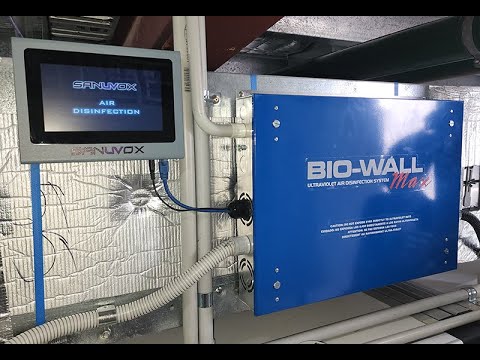
Score: 49/60 | Ideal For: Healthcare facilities (hospital isolation wards, operating suites), biotech/pharma labs, food processing plants, and large commercial HVAC systems requiring ultra-high UV germicidal doses for infectious disease control.
⭐ Overview: Sanuvox Bio-Wall is a powerhouse UV-C air purification system designed to deliver maximum irradiation to moving air streams. Unlike single-lamp “stick” UV lights, a Bio-Wall is an array of multiple high-output UV-C lamps (typically 5 lamps) mounted in parallel across a duct, each with its own parabolic reflector. This configuration ensures a very high UV dose (“kill dose”) to virtually all airborne microorganisms that pass through. The system is engineered based on Sanuvox’s proprietary sizing software to meet specific disinfection targets – for example, achieving a certain log reduction of spores at a given airflow. In fact, the Bio-Wall has been tested under ISO 15714:2019 standards for in-duct UV efficacy, validating its performance scientifically. In large air handlers, these units are typically installed in the return or supply plenum, parallel to airflow, maximizing contact time. The result: extremely high single-pass kill rates for bacteria and viruses (Sanuvox reports >90% kill for SARS-CoV-2 in one pass at rated airflow, and >99.99% within a few recirculations). The Bio-Wall also wipes out mold spores and can reduce VOCs if given enough contact time (though its primary role is germicidal). Each lamp is monitored and the control ballast box can tie into the building automation (dry contacts for lamp status). It’s CARB certified (zero ozone) and built with safety interlocks (since the UV intensity is hazardous to look at – normally enclosed in duct). While the Bio-Wall is a higher upfront investment and requires lamp replacements annually, it provides a level of air sanitization that rivals some industrial cleanroom systems. Essentially, it turns your duct into a UV disinfection chamber. For 2026, with infectious disease awareness high, the Sanuvox Bio-Wall offers peace of mind for critical environments where nothing less than the highest UV dosages will do.
🔧 Key Specs:
- Technology: Ultraviolet Germicidal Irradiation (UVGI). Uses 5 proprietary UVC lamps (length options 24″, 40″, 60″ depending on duct size) mounted on a frame with reflectors. Total UV power can be 250+ Watts, bathing the air in 254 nm light. It does not produce ozone (uses pure 254 nm emission).
- Installation: Typically installed in ducts or air handler plenums. The 5 lamps are attached to an aluminum frame that is inserted through an opening in the duct. They run parallel to airflow to maximize exposure time. A ballast/control panel (external to duct) powers the lamps and provides interface to BMS. Requires an access door (with safety interlock switch recommended to shut off UV if opened).
- Sizing & Coverage: Custom sized per project – Sanuvox provides software to determine how many Bio-Wall segments are needed based on duct size and disinfection goals. Generally, one Bio-Wall unit can handle an air handler of up to ~20,000 CFM with high disinfection; larger systems use multiple units. The goal is achieving specified log reductions (e.g. 99.9% kill of a target microbe per pass).
- Performance: Extremely high UV doses – on the order of hundreds of μW·s/cm². For example, independent tests show it can deliver >90% kill of airborne bacteria like Serratia in one pass at 500 fpm velocity. It also sterilizes surfaces like coils if installed downstream. Notably, the Bio-Wall has FDA 510(k) clearance when used in certain medical devices (Sanuvox also makes FDA-approved mobile UV units – same tech).
- Safety & Certification: CARB certified (complies with ozone <0.005 ppm). UL and CSA approved components. ISO 15714 tested for performance. The system includes UV safety features: viewing port filters, door interlock (optional), and warning labels. Maintenance staff must follow UV safety procedures due to the intensity.
- Maintenance: Lamp life ~12,000 hours (~≈ 1.5 years if 24/7, but Sanuvox typically recommends annual replacement to ensure max output). There are 5 lamps, so replacement cost is higher than single-lamp systems. The ballast box will alert to any lamp failure. Reflectors should be kept clean (usually they stay clean due to airflow and UV keeping dust from settling). Sanuvox lamps have a proprietary coating to minimize mercury degradation for long life.
🧪 Scoring Breakdown (Sanuvox Bio-Wall):
- Purification Effectiveness: 8/10 – Very High (for microbes). This system is among the most effective at destroying airborne pathogens – virus, bacteria, mold – even under high airflow conditions. It can easily achieve 99.99% reductions given sufficient recirculation time, essentially sanitizing the air to near-sterile levels. We score 8 because its effectiveness is narrower in scope: it doesn’t filter particles or target VOCs much (though high UV can break some VOCs, PCO is not its primary design). For pure germicidal performance, it’s a 10/10; but for comprehensive IAQ (dust, chemical), consider pairing with filtration.
- Technology & Innovation: 9/10 – Excellent. Sanuvox has innovated by creating a modular UV array with reflectors that greatly boosts effective UV dosage compared to standard UV lights. The Bio-Wall design maximizes “dwell time” and intensity. It’s a cutting-edge use of a proven technology (UV-C). It narrowly misses a 10 only because it’s essentially scaling up UV – very effectively, but not mixing multiple technologies.
- Installation & Integration: 7/10 – Moderate. Installing a Bio-Wall is a project – it involves cutting a large opening, mounting a multi-lamp frame, and ensuring the duct can accommodate the length of the lamps. In retrofit scenarios with small ducts, it might be tough. It does integrate well with BMS (you can get lamp status and turn it on/off remotely). Due to the complexity and need for proper sizing, professional installation is required, hence a lower score on ease.
- Certifications & Safety: 10/10 – Excellent. Sanuvox is used in hospital settings, so it meets stringent safety standards. It’s CARB certified for zero ozone. There is no chemical emission, just UV light contained in duct. It has been tested to applicable standards and the company provides engineering support to ensure safe use. Full marks here as it’s basically just light – and they include measures to prevent accidental exposure.
- Maintenance & Lifecycle: 7/10 – Fair. Lamps need yearly replacement ideally, and with five lamps, that’s a notable ongoing cost. Also, someone has to open the duct (with safety gear) to do this. It’s not difficult, but it’s more maintenance than simpler devices. On the plus side, the system itself is robust – the frame and ballasts will last many years, and lamp replacement is the only task. We give it 7 because of the frequency and cost of lamp upkeep.
- Value for Commercial Use: 8/10 – Good for specific needs. The Bio-Wall is a higher-end solution meant for critical air quality demands. Its value is apparent when you must ensure infectious agents are minimized (priceless in a hospital OR or an isolation ward). For a typical office, it might be overkill in cost. However, for what you get – a significant chunk of equivalent ACH purely via UV – the value is strong in the right context. It can allow a facility to meet health guidelines (like ASHRAE 241) that otherwise would require huge airflow increases or expensive filtration, which in itself is a cost benefit.
👍 Pros:
- Maximal Germicidal Power: Few, if any, HVAC purifiers can match the Bio-Wall in annihilating airborne microbes in real time. It’s effectively creating a disinfection zone in your duct akin to what’s used in biosafety labs. This is a huge reassurance for infection control.
- No Pressure Drop or Noise: Since it’s just light, the Bio-Wall doesn’t impede airflow or add any noise. Unlike HEPA systems, it won’t tax your fans or require upsizing equipment. You get air cleaning without airflow penalty (just ensure UV lamps fit).
- Proven & Trusted Brand: Sanuvox is a well-respected name in UV. Their systems are in service in hundreds of hospitals, government buildings, and even commercial jets. There’s ample validation and case studies on their effectiveness and durability.
- Secondary Benefits: By blasting the air handler interior with UV, the Bio-Wall also continuously disinfects coils, drain pans, and duct surfaces. This prevents mold and biofilms, which in turn keeps HVAC efficiency up and odors down.
👎 Cons:
- Higher Cost & Complexity: The initial cost of a Bio-Wall system is substantial, and installation is more complex than dropping in a small in-duct device. It’s an investment typically reserved for high-stakes IAQ requirements.
- UV Safety Considerations: Maintenance personnel must be cautious – direct exposure to these UVC lamps can cause instant eye and skin injury. Proper training and lockout procedures are a must. This is not a “plug-and-play” consumer gadget; it’s industrial-grade equipment.
- Limited VOC Removal: UV alone isn’t very effective on all VOCs at normal exposure times (unless they are very UV-sensitive). If odor or chemical pollution is a major issue, you might still need an adsorbent or PCO strategy alongside. The Bio-Wall’s focus is biological deactivation first and foremost.
🏁 Bottom Line: The Sanuvox Bio-Wall is the go-to solution when a facility’s mandate is to achieve the highest possible level of airborne disinfection short of filtering every molecule. It shines (literally) in healthcare and critical environments where pathogen control is paramount and downtime or risk must be minimized. While not every commercial building will need this level of UV firepower, those that do will find the Bio-Wall to be a reliable guardian of their indoor air. In the era of heightened concern over airborne disease, the Bio-Wall provides an engineering-driven, standard-compliant way to massively bolster your HVAC infection control. It’s a specialized tool – but an extremely powerful one – for creating safer, cleaner air in the most demanding settings.
🧭 Which Air Purification System Is Right for Your Building?
Choosing the ideal in-duct air purifier depends on your building’s priorities – whether it’s germicidal power, pollutant type, maintenance capability, or budget. Here’s a quick decision guide:
- For All-Purpose IAQ Improvement: If you want a balanced solution that knocks out a bit of everything (germs, odors, and some particles) with minimal fuss, 🥇 RGF HALO-LED is a top pick. It’s best for “most buildings” looking for a broad-spectrum active purifier that’s easy to retrofit and proven in efficacy. Offices, schools, and retail spaces will benefit from its combination of technologies and set-and-forget operation.
- For Maximum Particle Removal & Health Standards: If your goal is to meet hospital-grade air quality or stringent health guidelines (e.g. hospitals, labs, high-rise offices aiming for WELL standards), consider 🥈 HealthWay Super V. This DFS filtration unit will deliver the cleanest air by physically removing and destroying contaminants. It’s slightly more involved to install, but yields huge returns in air purity – great for smoke-prone regions or healthcare facilities.
- For Odor and Chemical Concerns: Buildings plagued by odors (restaurants, clinics with chemical off-gassing, fitness centers, etc.) should look at 🥉 Fresh-Aire UV APCO-X. Its UV+PCO system excels at neutralizing VOCs and smells – creating fresher, healthier air without any scented cover-ups. Plus, it will keep your HVAC coils pristine. It’s a superb choice where “air freshness” is as important as germ reduction.
- For Large Scale and Energy-Sensitive Projects: If you manage a large venue or campus and need an IAQ solution that scales economically, #4 AtmosAir Matterhorn (Bipolar Ionization) is designed for you. It provides distributed air cleaning via ions that can cover stadium-sized volumesatmosair.com. Importantly, it can help you reduce outside air requirements by providing “equivalent clean air” internally, which can significantly cut HVAC energy costs while maintaining safety. Choose this for big arenas, airports, or older buildings where increasing ventilation is impractical.
- For Critical Infection Control: When nothing short of the highest germicidal action will suffice – for instance, a hospital ICU, an eldercare facility, or a biohazard laboratory – #5 Sanuvox Bio-Wall is the answer. It’s essentially a sterilization chamber in your ductwork, capable of decimating pathogens on contact. Use this in scenarios where you need to meet or exceed ASHRAE 241’s toughest requirements for infectious aerosol mitigation. The investment is higher, but so is the protection level.
Lastly, always ensure any system you choose is properly sized and installed for your specific HVAC setup. A well-installed mid-range purifier will outperform an oversized misapplied one. Consult manufacturer guidelines or an HVAC engineer when in doubt. All the top 5 systems above are supported by US-based manufacturers/distributors, so replacement parts and tech support are readily available. By selecting the purifier that best aligns with your building’s needs, you’ll be on the way to achieving cleaner, healthier indoor air – an investment that pays dividends in occupant wellness and comfort.
